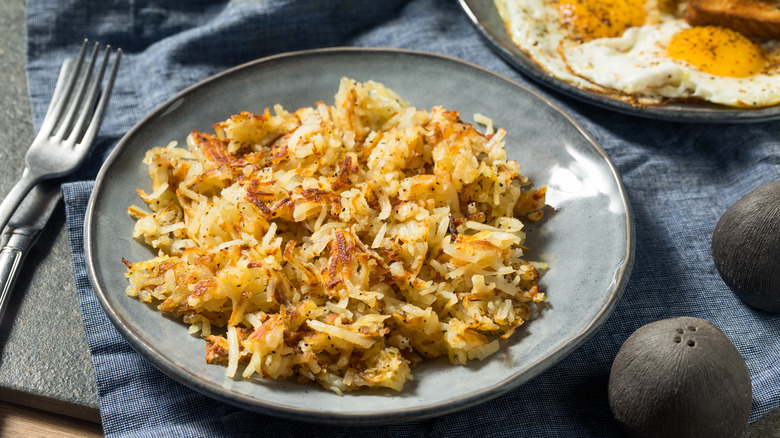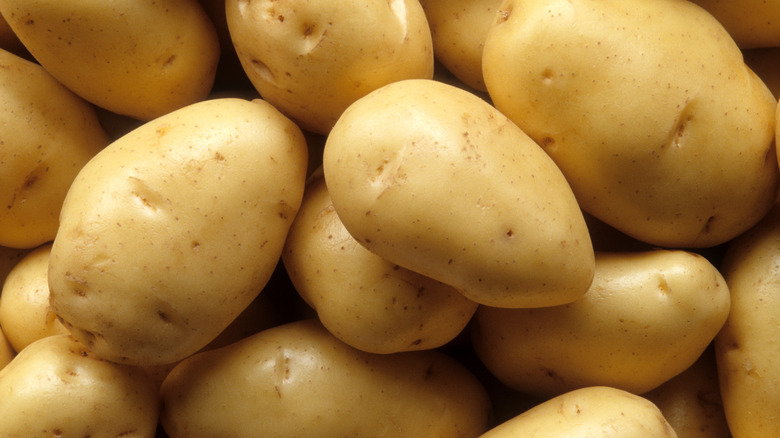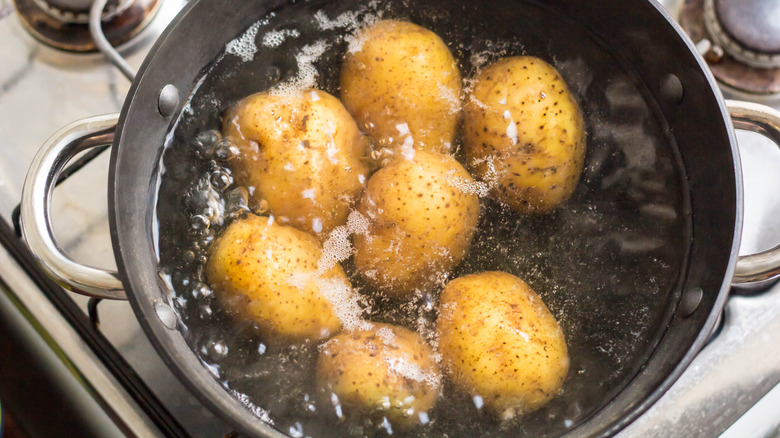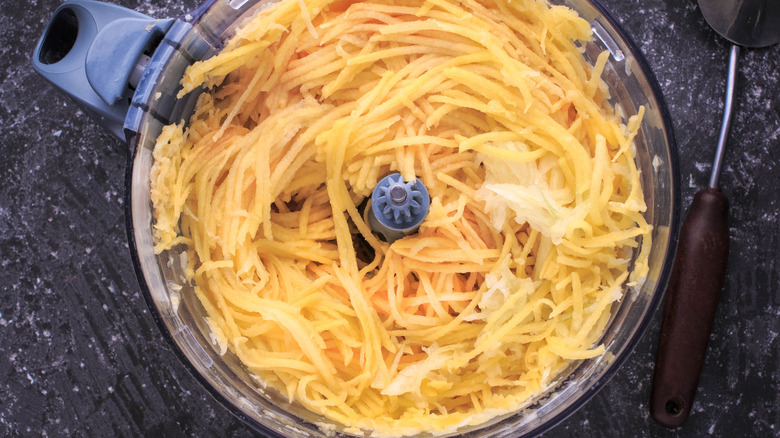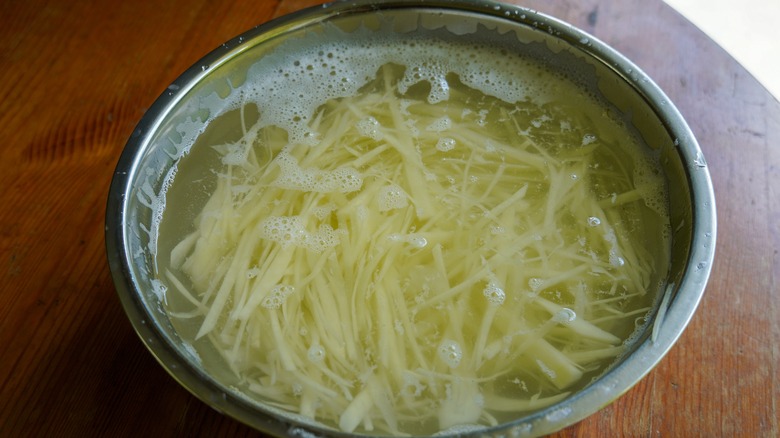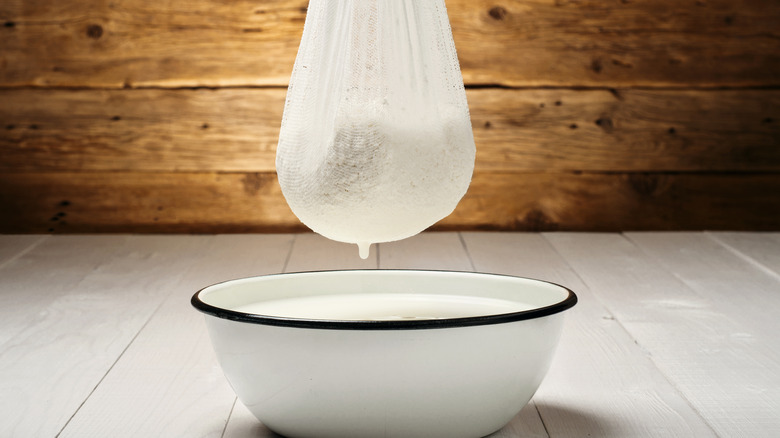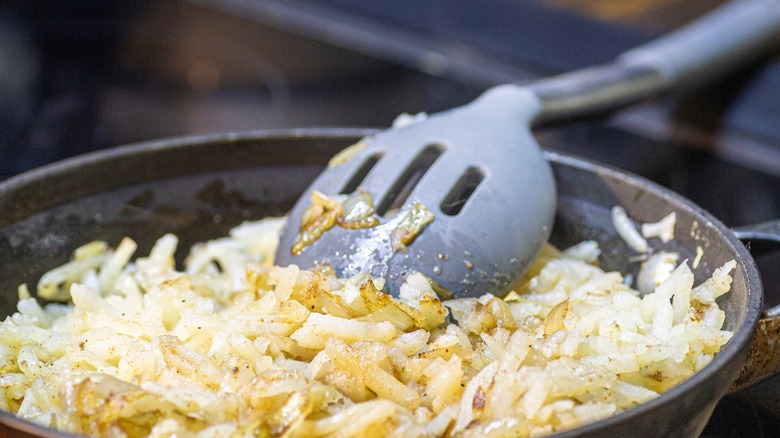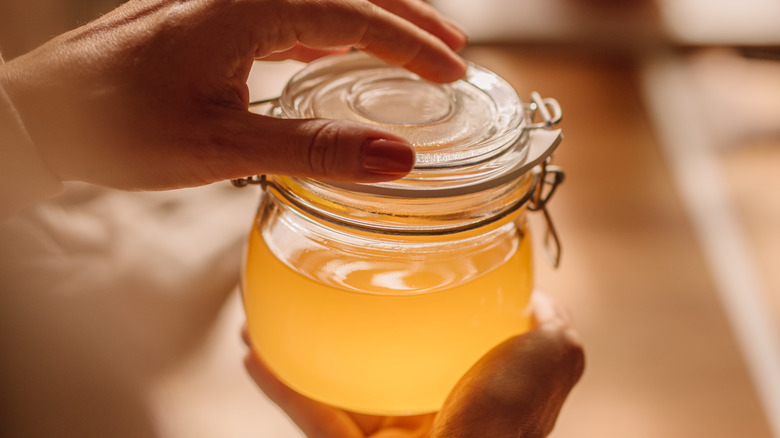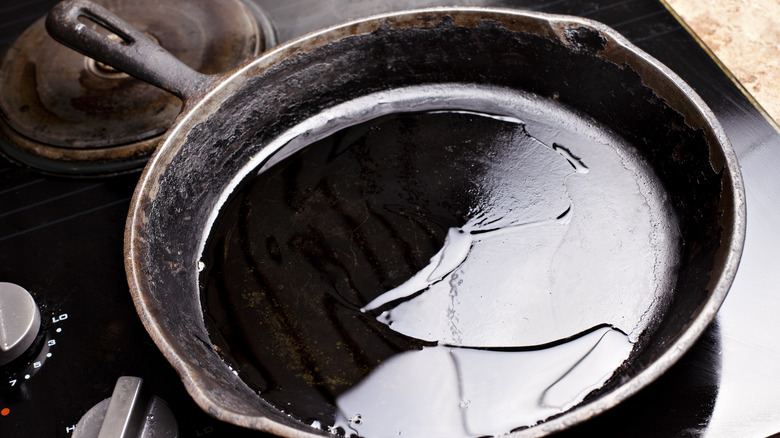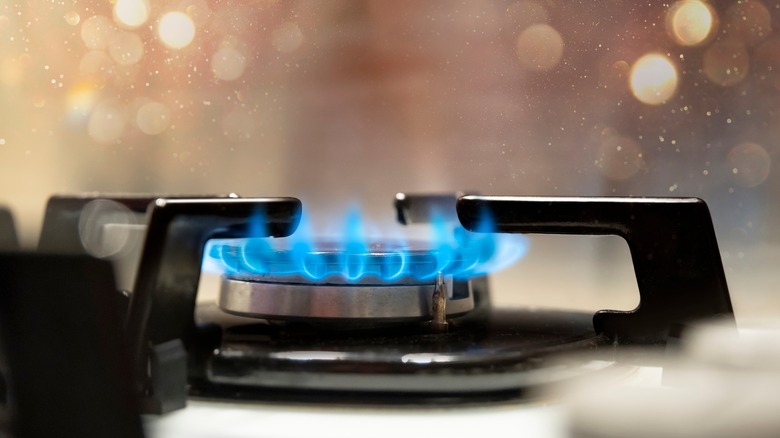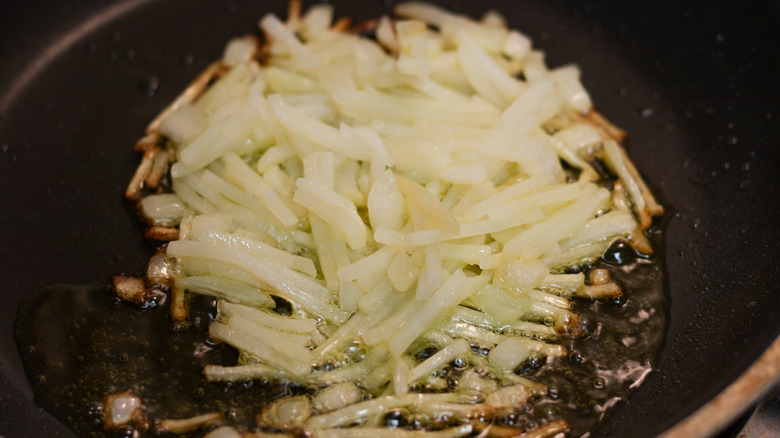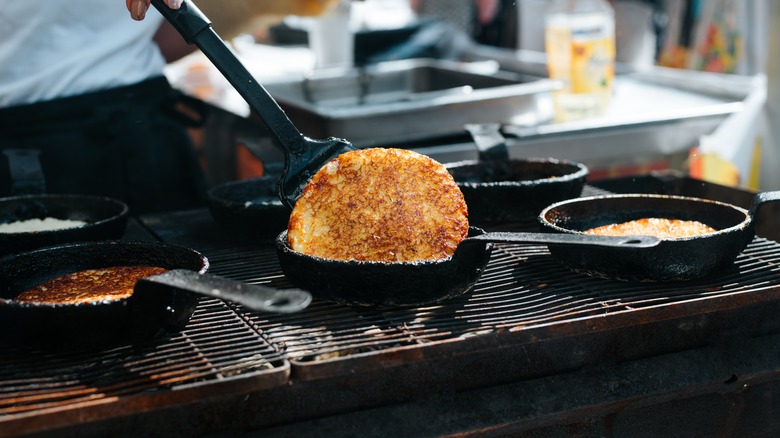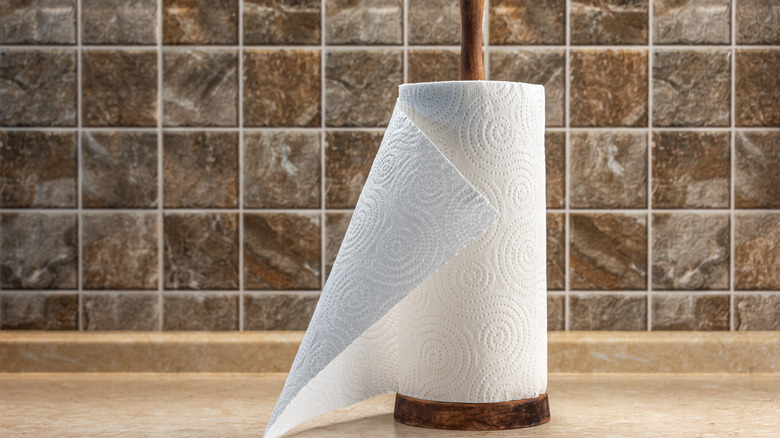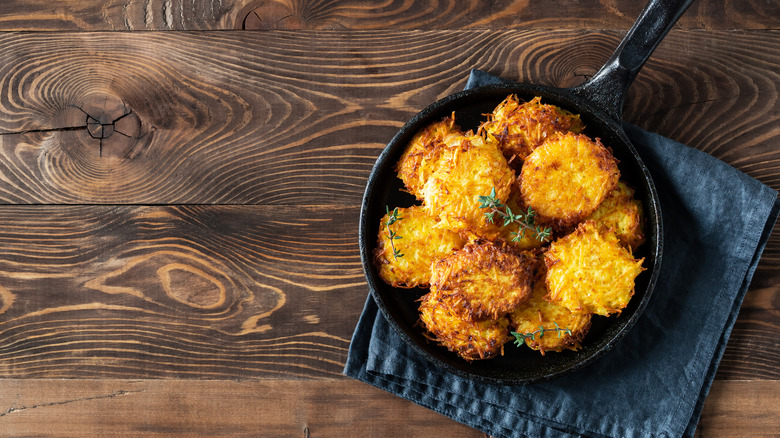13 Tips For The Perfect Hash Browns Every Time
Anyone who's had perfectly crispy hash browns knows they're an elite breakfast food. Best friends to the egg, hash browns do a wonderful job sopping up the egg's rich yolk while maintaining a delicious crunchy texture. And despite having a golden crust on the outside, the middle is warm, tender and fluffy. It's almost a no-brainer to order hash browns if they're on the menu at a diner or fast food restaurant. But if you've ever attempted the feat of making them at home, you know it's a bit more complicated. Hash browns are notoriously easy to mess up, and often can come out on the mushy side.
However, mastering the art of crispy hash browns at home is not as elusive as it may seem. There are a few tricks that can guarantee crispy, crunchy hash browns every time. From choosing the right potatoes to rethinking traditional methods, here's what you need to know to avoid soggy hash browns forever.
Choose Russet potatoes
Not all potatoes are created equal. And when it comes to making hash browns, the type of potato you use matters. You want to look for potatoes that are starchy instead of waxy. A potato that's high in starch will be low in moisture, which makes them ideal for cooking. The lack of moisture gives potatoes an even color when cooking, and allows them to absorb some of the oil when frying. This gives the hash browns its fluffy, tender interior. These drier varieties will also give the outer layer of your hash brown a golden crust.
Russets are the ideal potato to use for hash browns since they have a high starch content. Though less popular than the standard potato, sweet potatoes are also a perfect starchy alternative. (If you try this, a dash of cinnamon makes a great topping.) To prevent subpar hash browns, avoid waxy potatoes like red-skinned and fingerling potatoes.
Use boiled potatoes
Homemade hash browns can sometimes carry a starchy, raw taste that isn't everyone's favorite. This can happen if you use too many shredded potatoes or if the pan is too hot, two common scenarios that can both lead to a hash brown with an undercooked middle. These mistakes are easy to make, especially if you're new to cooking hash browns at home. Luckily, there's a hack to make sure the insides are creamy and perfectly cooked while the outside has a golden crust that's not overdone. The key is boiling the potatoes before frying them.
Boiling your potatoes will ensure they're cooked all the way through so the only thing you have to worry about is getting the outside perfectly crisp. It's also another way to release the excess starch from the potato, which is typically achieved by soaking the shredded potatoes in water and drying them — so you can skip this step altogether. To make hash browns with boiled potatoes, boil them until they're tender. Bear in mind that you don't want them to be too mushy, so don't boil the potatoes for too long. Grate them once they're cool enough to touch.
Use a food processor to shred potatoes
The method used to grate the potatoes has a huge impact on the crispiness of the hash brown. To achieve the perfect crust, the potato shreds should be long, thin and consistent in size and shape. Traditional hash brown recipes call for a food grater to shred the potatoes — and while this will certainly work, there's arguably a better method.
When it comes to preparing potatoes for hash browns, food processors reign supreme. This method is exemplary for a few reasons. For one, it ensures your potatoes will be uniform in size and shape, which will help the hash brown achieve a perfectly even cook. Food processors can also shred your potatoes into perfect strands in a matter of seconds, which is significantly quicker, and easier, than putting in the work to break down the potato manually. Clean-up is also a breeze since the processor will keep your potato shreds contained in one place.
Don't soak the potatoes beforehand
Soaking your potatoes is almost like the standard in hash brown recipes, but have you ever wondered why? The goal in this preparation method is to wash away excess starch from the raw potato as well as prevent oxidation, which is when potatoes turn a gray or brown after being exposed to air for too long. But as long as you rinse your raw potatoes before cooking and you work quickly, you won't run into either of those problems.
The thing is, if you soak your potatoes in water that isn't cold enough, you run the risk of soaking them for too long, which can actually make your hash browns mushy — especially if you fail to adequately drain out the liquid. A safer alternative would be to thoroughly rinse off the potato strands in water before wringing them dry. This will effectively remove excess starch from the potato without oversaturating the potato with liquid. And while oxidation might look unappetizing, it's pretty harmless. Plus, it can be easily prevented. Just make sure you don't let raw potatoes sit out for longer than a few minutes.
Dry your potatoes before frying
An essential step to the hash brown recipe is drying your potatoes before frying them. It doesn't matter if you soaked your potatoes, rinsed them, or boiled them two days ago, excess moisture from the potato needs to be removed. This will allow the hash browns to stay together and form that delicious golden crust on the outer layer. Too much water will simply steam the hash browns instead of making them crispy. The end result would be the worst case scenario: soggy hash browns.
There are a few effective ways for drying out potatoes. A tried and true method is wrapping the shredded potatoes in a cheesecloth or kitchen towel and twisting out every last drop of liquid. Have a salad spinner on hand? This can also help dry out your shreds. And don't stop there — a final pat down with a paper towel will ensure your potatoes are as dry as possible.
Use a cast iron skillet
Non-stick pans are a totally acceptable option for cooking hash browns. But if you want a super crispy, evenly cooked hash brown every time — and who doesn't — a cast iron pan is going to be your best bet. They are phenomenal heat conductors, keeping the entire pan hot so every part of the hash brown is fried to perfection. That also means they can maintain a stable temperature while cooking, which helps to achieve a crispy exterior. And since these cast iron pans can get really hot, there's a better chance you'll achieve a crust before overcooking the hash. Be careful, though, cooking hash browns over too high of heat can easily burn your potatoes, so set your burner at medium heat to be safe.
When cooking with a cast iron pan, allow your pan plenty of time to heat up, then add oil (as much as you need to cover the bottom of the pan) before throwing in your raw shredded potatoes. Make sure to use a well-seasoned cast iron pan to prevent the hash browns from sticking to the sides.
Avoid frying in butter
Butter isn't the best fat to use for frying since it has a low smoke point, meaning the fat in the butter will start to smoke when cooked at relatively low temperatures. Anything hotter than 350 degrees F and butter will start to release a colorless liquid called acrolein, which smells and tastes extremely unpleasant. Food, including hash browns, are typically fried at 350 degrees F, so you run the risk of inching past that smoke point, which can lead to a bitter flavor in your hash browns. In general, it's better to stick with oil when frying. Specifically, an oil with a high smoke point. Think safflower oil, refined olive oil, or peanut oil. These all share a smoke point of at least 450 degrees F.
We know what you're thinking. It's a bit disappointing leaving butter out of a hash brown recipe. It's too good not to. But what if we told you there's a very special type of butter that tastes even richer than its better known counterpart and has a higher smoke point? Yep, it's real, and it's called clarified butter (aka ghee). You might have heard of it, but if you haven't, it's essentially butter with the milkfat removed. Milkfat has a low smoke point, and when it's eliminated along with the water, you're left with the more heat-tolerant ingredient, butterfat. Clarified butter is fair game when it comes to safe fats to fry up your hash browns in, so consider using this to get the delicious buttery flavor without the risk of the bitter taste.
Don't use too much oil
You might think that since you're frying hash browns, adding a bunch of oil will make them extra crispy. Similar to how submerging long, rectangular cuts of potato in frying oil will make crunchy french fries. But in reality, the opposite is true. In fact, adding too much oil to your pan will result in mushy, soggy hash browns. If there's too much oil, and it's not at the right temperature, it's likely the shredded potatoes will soak up too much of it, which will make your hash browns too moist and weigh them down.
In the same vein, you also want to be careful about using too little oil in your pan. If this happens, your shredded potato bits will cling onto the pan, possibly even burning, and your hash browns will be nearly impossible to flip. You'll be left scraping what you can off your pan instead of enjoying a neat pile or patty of shredded potatoes. So what's the best amount of oil to use when frying up hash browns? Use as much as you need to cover the bottom of the pan in a thin layer.
Cook at the right temperature
Frying your hash browns at the right temperature is a crucial step for getting a golden crust. Too hot, and you'll end up with raw potatoes in the center or a burnt outer layer. And if your pan isn't hot enough, the hash browns will steam rather than fry, so the outside won't crisp — plus there's a chance your shreds will stick to the pan completely. The best temperature to fry hash browns is 350 degrees F. When working with a pan on a stovetop, setting the burners to medium heat will allow the hash browns to get crispy without the risk of burning. This will obviously depend on your stove, though. If it runs hot, a lower setting might be better.
Also keep in mind that your pan and oil should be hot before adding in your shredded potatoes. The trick is to be patient when preheating the pan. A steady heat is key. Once you add your oil and it starts shimmering, it'll be ready for your potatoes.
Use a thin layer of shredded potatoes
A rule of thumb for adding raw shredded potatoes in the pan is to create a thin layer. The goal is to have as much of the potato shreds exposed to the pan as possible — this will give your hash brown a nice crust and an even cook. If your stack of shredded potatoes is too thick, the insides of the hash brown won't cook all the way through. Overcrowding the pan will cause the hash brown to steam, and instead of a crispy hash brown, you'll get a soggy, mushy one. Try to avoid using too little potatoes in your hash brown, since this can lead to a burnt crust.
It also helps to flatten the layer of shredded potatoes further once it's on the pan by pressing your spatula over the top. That way, each potato strand has optimal contact with the pan's surface for a more consistent crust.
Don't disturb the potatoes while cooking
Once your potatoes are in the pan, try not to touch them. Stirring or moving around your shreds could prevent the hash browns from reaching their crispiest potential. Letting the potatoes sit in the pan undisturbed is the key for the perfect crunchy texture. This also applies to flipping the hash browns. Patties only need to be flipped one time, once the first side forms a golden crust.
The sound of raw potato shreds sizzling in the pan is completely normal, and isn't a sign to pull it off the heat. In fact, you should wait at least four to five minutes for the hash browns to fry completely on one side. Once you see the edges of your hash browns start to crisp up, gently pull up the side to take a peak underneath. If it picks up easily and a visible crust has formed, it's ready to be flipped.
Remove excess oil from hash browns
So you've fried both sides of your hash browns sufficiently, and they're sitting in the oil, ready to be taken out. If your instinct is to grab a paper towel, then you're definitely a natural. Putting your oily hash browns directly on a paper towel-lined plate after frying is a pro move. It's the best method for absorbing excess oil from the hash browns so it's less greasy to the touch.
A common recommendation in a traditional hash browns recipe is to place your hash browns on a wire rack to rest, letting the air work its magic as it dries out the patty. However, the paper towel is so effective at soaking up moisture that it just does a better job than gravity ever could. You only need to let the patty sit on the paper towel for a few seconds, and don't forget to blot the tops of the hash browns as well.
Serve immediately
Hash browns are undoubtedly at their prime moments after they're done cooking. Fresh out of the oil is when they've reached the optimal taste and crispy texture. So, you might want to consider planning ahead so the hash browns are among the last to cook (along with your eggs, of course). That way, your guests — and you — can enjoy the toastiest and crunchiest hash browns possible. If they sit out too long, hash browns will get cold and lose their tenderness.
But, the reality is that sometimes life gets in the way and they can't be served immediately. Not to worry, they'll still have the perfect texture and taste if they're kept warm properly. To do this, set your oven to 200 degrees F and place your hash browns on a sheet pan. As long as they sit in the oven, they'll be ready when you are. Be aware, though, they'll dry out if they're in the oven too long, so try to serve them ASAP.

